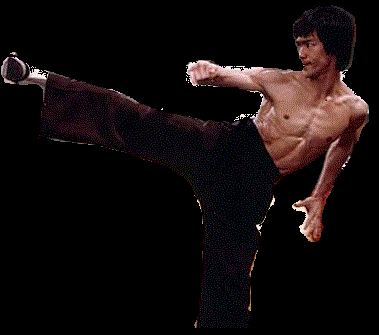Jeet Kunde Do
Jeet Kune Do (截拳道; (Pinyin: Jiéquándào, Cantonese: Jitkyùndou, Jyutping: Zit6 Kyun4 Dou6, also "Jeet Kun Do", "Jeet Kune Do" or simply "JKD") is an eclectic/hybrid system and philosophy of life founded by martial artist Bruce Lee with direct, non classical, and straightforward movements. Due to the way his style works, Jeet Kune Do practitioners believe in minimal movement with maximum effect and extreme speed. The system works on the use of different 'tools' for different situations. These situations are broken down into ranges (Kicking, Punching, Trapping and Grappling), with techniques flowing smoothly between them. It is referred to as a "style without style" or "the art of fighting without fighting" as said by Lee himself. Unlike more traditional martial arts, Jeet Kune Do is not fixed or patterned, and is a philosophy with guiding thoughts. It was named for the concept of interception, or attacking your opponent while he is about to attack. However, the name Jeet Kune Do was often said by Lee to be just a name. He himself often referred to it as "The art of expressing the human body" in his writings and in interviews. Through his studies Lee came to believe that styles had become too rigid, and unrealistic. He called martial art competitions of the day "Dry land swimming". He believed that combat was spontaneous, and that a martial artist cannot predict it, only react to it, and that a good martial artist should "Be like water" and move fluidly without hesitation.
Lee's philosophy:
Jeet Kune Do (JKD) is the name Lee gave to his combat system and philosophy. Originally, when Lee began researching various fighting styles, he gave his martial art his own name of Jun Fan Gung Fu. However not wanting to create another style that would share the limitations that all styles have, he instead described the process that he used to create it:
"I have not invented a "new style," composite, modified or otherwise that is set within distinct form as apart from "this" method or "that" method. On the contrary, I hope to free my followers from clinging to styles, patterns, or molds. Remember that Jeet Kune Do is merely a name used, a mirror in which to see "ourselves". . . Jeet Kune Do is not an organized institution that one can be a member of. Either you understand or you don't, and that is that. There is no mystery about my style. My movements are simple, direct and non-classical. The extraordinary part of it lies in its simplicity. Every movement in Jeet Kune-Do is being so of itself. There is nothing artificial about it. I always believe that the easy way is the right way. Jeet Kune-Do is simply the direct expression of one's feelings with the minimum of movements and energy. The closer to the true way of Kung Fu, the less wastage of expression there is. Finally, a Jeet Kune Do man who says Jeet Kune Do is exclusively Jeet Kune Do is simply not with it. He is still hung up on his self-closing resistance, in this case anchored down to reactionary pattern, and naturally is still bound by another modified pattern and can move within its limits. He has not digested the simple fact that truth exists outside all molds; pattern and awareness is never exclusive. Again let me remind you Jeet Kune Do is just a name used, a boat to get one across, and once across it is to be discarded and not to be carried on one's back"-Bruce Lee
JKD as it survives today — if one wants to view it "refined" as a product, not a process — is what was left at the time of Lee's death. It is the result of the lifelong martial arts development process Lee went through. Lee stated that his concept is not an "adding to" of more and more things on top of each other to form a system, but rather, a winnowing out. The metaphor Lee borrowed from Chan Buddhism was of constantly filling a cup with water, and then emptying it, used for describing Lee's philosophy of "casting off what is useless". He used the sculptor's mentality of beginning with a lump of clay and hacking away at the "unessentials"; the end result was what he considered to be the bare combat essentials, or JKD. The dominant or strongest hand should be in the lead because it would perform a greater percentage of the work. Lee minimized the use of other stances except when circumstances warranted such actions. Although the On-Guard position is a good overall stance, it is by no means the only one. He acknowledged that there were times when other positions should be utilized.
Lee felt the dynamic property of JKD was what enabled its practitioners to adapt to the constant changes and fluctuations of live combat. He believed that these decisions should be done within the context of "real combat" and/or "all out sparring" and that it was only in this environment that a person could actually deem a technique worthy of adoption.
Lee did not stress the memorization of solo training forms or "Kata", as most traditional styles do in their beginning-level training. He often compared doing forms without an opponent to attempting to learn to swim on dry land. Lee believed that real combat was alive and dynamic. Circumstances in a fight change from millisecond to millisecond, and thus pre-arranged patterns and techniques are not adequate in dealing with such a changing situation. As an anecdote to this thinking, Lee once wrote an epitaph which read: 'In memory of a once fluid man, crammed and distorted by the classical mess.' The "classical mess" in this instance was what Lee thought of classical martial arts.





